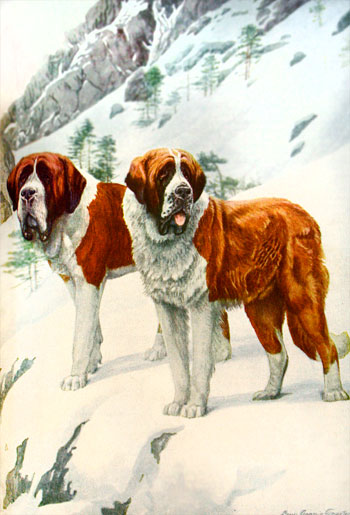Dog Breeds
Dog Tips
Training
Exercise
Medical
Interviews
Miscellaneous
About DB
Contact DB
Resources

Illustration by Louis Agassiz Fuertes
Saint Bernard
The St. Bernard won both his name and his fame in the Swiss Alps, where for many years the monks of the Hospice St. Bernard have used dogs to assist them in saving the lives of travelers lost in the snow. One of these dogs, Barry, saved 40 people and was killed by the 41st, who mistook him for a wolf.
But the dogs used by the monks have changed greatly in appearance from time to time. Occasionally an avalanche will destroy a large number, and those remaining will be bred to Newfoundlands, Pyrenean sheep dogs, and others having similar characteristics.
Some of the dogs kept at the hospice now resemble powerful foxhounds and would never be admitted to an American bench show in competition with modern St. Bernards, either smooth or rough coated, such as are pictured.
The old-time working hospice dog had none of the grandeur of this more modern successor to his name, which has been compounded rather recently of several other dogs. Still he is about the most distinct of any of the large dogs, the Newfoundland being the only dog even remotely resembling him.
Like all very large heavy dogs, this breed is greatly given to weakness in the legs, cowhocks and weak hips being rather the rule than the exception. The "dewclaw," or extra hind toe, is also generally present (and was formerly considered desirable).
The perfect St. Bernard is a very large, very strong, straight-backed, strong-legged, and heavily organized dog, the colors, as shown, being those most eagerly sought. They may be either rough or smooth in coat. The best American dogs are those of Mr. Jacob Rupert, of Newark, N.J., and Miss C.B. Trask, of California. Indeed, it is doubtful if their dogs are to be surpassed anywhere.
The benign St. Bernard should show, in both types, broad, domed, massive head, loose skin, deep-set, rather mournful eye, haw quite pronounced, and deep-folded flews and dewlap, though he should not be too "throaty." What is not mentioned in most brief accounts of this dog is the tremendously impressive voice in which he speaks. Probably no other dog has such a deep bass voice, nor such a volume of it. Yet it is as benign and kindly as his expression of countenance, and would tend rather to inspire hope and confidence than fear, even with the timid.
The deep personal affection with which St. Bernard owners invariably invest their companions is the best expression of the character of these great, dignified and rather somber dogs, which inspire no fear, even in little children, and which return the stranger's gaze with a look of calm, steady, and indulgent tolerance, and endure the advances of the unacquainted with a patience and dignity that speak worlds for their gracious and enduring disposition.
Did you enjoy this article? Let us know what you think by commenting below. Don't forget to Friend us on facebook and subscribe to our twitter feed to stay updated! Thanks for reading, recommend us to your friends! |